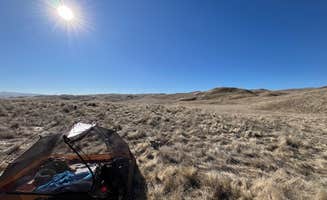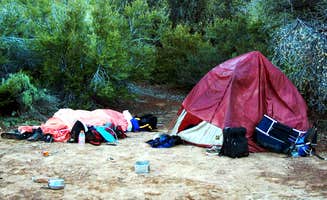Primitive camping near Los Olivos, California occurs primarily on rugged terrain with elevations ranging from 1,200 to 4,500 feet. Most dispersed sites experience temperature variations 10-15 degrees different from forecasted valley temperatures. Summer conditions can reach over 100°F while winter nights at higher elevations often drop below freezing.
What to do
Hiking access: Chorro Grande Trail near Los Padres National Forest Dispersed Camp offers substantial backcountry hiking options. "This site is next to chorro grande trail which is about a 9 mile hike. After your long hike if you want to rest go up the mountain site across and it's an awesome place to camp out," notes Jessica P.
Wildlife viewing: Carrizzo Plain National Monument Dispersed camping areas provide exceptional wildlife observation opportunities during spring months. "Beautiful hilly landscape. Despite the absence of trees or bushes for shadow, we had a wonderful evening here, on our way to santa barbara," reports Gert K. The area features open grasslands where visitors can spot pronghorn antelope and various bird species.
Stargazing: Remote locations away from light pollution create premium night sky viewing conditions. Jonathan E. describes his experience at Carrizzo Plain National Monument Dispersed: "The stars were also quite visible with minimal light pollution. The area is hilly and beautiful with enough flatness and openness to pitch a tent without issue."
What campers like
Privacy options: Several dispersed sites offer secluded spots set back from main roads. "Picked the first nook from the GPS pin but hiked up road and there are quite a few others, some shaded, some exposed," writes Jason R. about Old Sierra Madre.
Cell connectivity: Unlike many remote camping areas, several sites maintain reasonable communication options. As Elyse B. notes about Old Sierra Madre, "Pretty solid! Had great cell service and was a lovely drive to get there. Probably wouldn't recommend if you have a tent or RV as the spots were a little small and rocky."
Wind protection: Finding sheltered spots significantly improves camping comfort. A camper at Chorma Camp in Matilija Wilderness advises: "Situated high on a bluff it gets lots of wind, and with very little shelter around to break it, if you camp here you will get the brunt of it... Continuing on past Chorma if you can make it to Maple it is better campsite down in the valley."
What you should know
Temperature variations: Actual nighttime temperatures frequently drop well below forecasted levels, particularly in winter. Jonathan E. warns about Carrizzo Plain: "It was about 15 degrees (F) colder than was forecasted (20 F vs 35 F) at night, so be prepared to be a bit chilly if visiting during the winter."
Road conditions: Access roads deteriorate quickly during wet weather, making travel hazardous without appropriate vehicles. Natalie T. reports from Carrizzo Plain National Monument Dispersed: "Arrived on a drizzly day & tried going further down the road to other more secluded camping spots. However the dirt road was slick & minivan, loaded down, was slipping & sliding."
Private property boundaries: Several dispersed camping areas border private land with unclear boundary markers. Mareike W. at Morrow Hill Dispersed advises: "Make sure, you really stay at the place up the hill (coordinates) otherwise the landlord will clarify that you're on private property."
Tips for camping with families
Site selection criteria: When primitive camping with children, prioritize locations with natural barriers and level ground. Connor B. describes Old Sierra Madre: "pretty easy to find, road is also easy to drive. found a pretty good level spot, definitely camping right off the side of the road. pretty nice and low key tho."
Noise considerations: Some primitive sites experience traffic noise that may disturb light sleepers. Jason R. notes about Morrow hill dispersed: "Lovely hillside spots... Bit of highway noise." Consider sites further from main roads when camping with children.
Water planning: No reliable water sources exist at most dispersed sites, requiring families to carry 1-2 gallons per person per day. Most campsites require complete water self-sufficiency for drinking, cooking, and basic hygiene.
Tips from RVers
Size limitations: Most dispersed areas accommodate only smaller recreational vehicles. Jacob B. advises about Old Sierra Madre: "Easy spots to turn around and park. Beautiful views, slight road noise if you're not in the van but quiet inside. Wouldn't recommend anything bigger than a extended sprinter or transit."
Leveling challenges: Prepare for uneven parking at most sites. Mareike W. reports success at Morrow Hill: "We had a great and quiet night up there in our 21ft RV. But the road is a little tricky and we almost wouldn't have driven there... Great view in the morning, beautiful."
Turnaround space: Limited maneuvering room exists on many forest roads leading to primitive sites. RVs exceeding 21 feet face significant challenges finding suitable parking and turn-around options.





